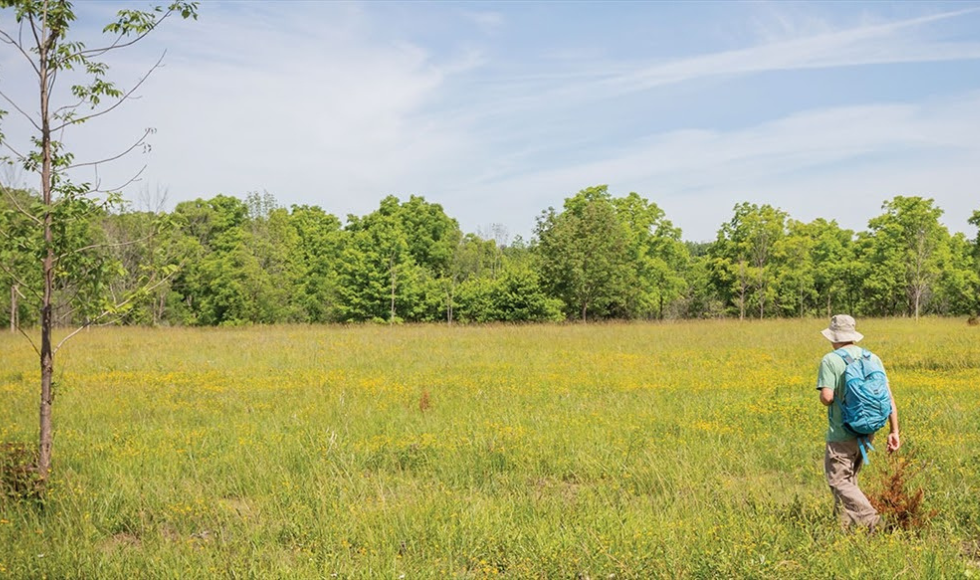Shell game: Uncommon wild bee thrives by nesting in old snail shells

Sebastian Irazuzta, a graduate student in the Department of Biology at McMaster University and co-author of the study at the McMaster Forest Nature Preserve.
BY Wade Hemsworth
July 12, 2023
McMaster biologists studying the local abundance of a typically uncommon wild native bee have found a clear link between the unusual population spike and the concentration of a non-native snail in the same area.
This native bee, a species of mason bee called Osmia conjuncta, uses the empty shells of dead snails to incubate its offspring. Though several species of bees commonly nest in snail shells in Africa, Asia and Europe, little research had previously been done on shell-dwelling bees in North America.
The shells of European grove snails, which can proliferate in near-urban fields, come in an array of sizes and colours. These non-native snails happen to be especially abundant in Hamilton and parts of Niagara— 20 times greater than in comparable habitats elsewhere.
The work, led by undergraduate student Isobel Fanaki and graduate student Sebastian Irazuzta and supervised by Professor Susan Dudley, is described in a new article in the journal The Canadian Entomologist.
The supply of suitable shells in the study area allows the bees to choose optimal nurseries for their offspring, boosting their local populations.

“Grove snails are non-native, but they have been considered benign because they only eat dead plants,” Dudley says.
“What this study implies is that they have made an ecological impact in North America by providing a super-abundant nesting resource for one species of bee.”
The finding is part of a rich cache of new quantitative information about the otherwise sparsely distributed bee, which is also abundant in Hamilton and Niagara.
The McMaster team carefully mapped the presence of shells and bees in grassland sections of the McMaster Forest Nature Preserve, a 47-hectare (115-acre), university-owned property not far from campus, which features a restored prairie set between forested ravines.
The researchers measured off one-metre sample sections in the study area and counted as many as 87 suitable shells in a single square metre. On average, they found 11 suitable nesting shells per square metre, a huge number compared to other North American snail studies, which have found there is typically only one shell of the right size for bees to use per two square metres.
The researchers learned the nesting bees use a Goldilocks-like approach, typically rejecting the largest and smallest shells and the darkest and lightest shells.
The biologists believe the bees turn down newer, darker shells because of the higher risk of contamination and infestation from the bodies of decomposing snails inside, and that they also reject the most faded older shells, likely because they are more brittle and offer less protection.
The abundance of ideal incubators for the solitary bees has created a much more robust population in the study areas than is typically found elsewhere.
The McMaster researchers found snail shell-nesting bees represent roughly one in five of all wild bees in their study area, compared to fewer than one in 300 in other parts of North America where they are present at all.
“This is an interesting example of how a seemingly unrelated non-native species has led to the proliferation of a previously uncommon native bee,” Irazuzta says.
“It’s incredible that while Osmia conjuncta has been listed as a snail shell-nesting bee for decades, the only published evidence of this trait has been an anecdotal account from 1937,” Fanaki says.
“This research gives us more concrete evidence that this species is a snail shell-nesting bee after all. While it may seem a little obvious, confirming this simple fact is very helpful for future study.”
The findings are also significant because they reveal the success of one species of wild bee while the broader population of wild native bees is under threat, both from domesticated honeybees which compete with them for food, and from human encroachment.
Wild bees and other native pollinators are critical to preserving the diversity of plants, which is critical to the health of the environment.


